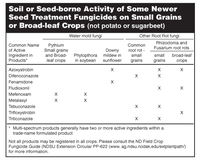Use Fungicide Treated Seed to Prevent Diseases
(Click the image below to view a high-resolution image that can be downloaded)
Less than ideal planting conditions (floods, waterlogged soils, cold temperatures) may challenge the establishment of crops this summer. One common concern plant pathologists have in these conditions is the loss of stand and yield due to seedling blights and root rots.
Poorly drained and wet or cold soils will slow crop germination and favors soil-borne pathogen activity.
“Examples of fungi that can cause seed and root rot under wet, cold conditions include various Pythium species that attack many crops, the Phytophthora root rot fungus of soybeans and the downy mildew fungus that attacks sunflowers,” says Marcia McMullen, North Dakota State University Extension Service plant pathologist.
“If the soils become warmer, but are still wet, conditions favor infection by a number of other soil-borne fungi, such as the common root rot fungus on small grains and the Fusarium and Rhizoctonia root rot fungi of multiple crops. Re-ccurring wet conditions following germination and emergence also favor root rot development.”
Even if soil conditions improve later in the season, early infections still may rob yield.
“Sometimes the greatest yield loss from root rot occurs in years that begin wet and become dry,” says Sam Markell, NDSU Extension Service plant pathologist. “When water is abundant (wet soils), even an infected root system may be able to extract enough moisture for the plant. However, when the soil becomes dry, a diseased root probably will not have the ability to extract enough moisture to reach maximum yield potential. Additionally, Fusarium and Rhizoctonia may continue to develop even when soil begins to dry, which will exacerbate the problem.”
Fortunately, many broad-spectrum seed treatment fungicides are available to protect against soil-borne fungi, as well as protect against seed-borne diseases. Many contain mefenoxam or metalaxyl fungicides that protect the seedling against water mold fungi, such a Pythium or Phytophthora. They also contain a fungicide, such as a triazole or strobilurin, that acts against most fungi other than the water molds.
“A product that contains a combination of chemicals with different targets (broad-spectrum seed treatment) generally is recommended under these disease-favoring conditions,” Markell says. “Otherwise, a mix of single-acting products may be needed. Some commercial products contain two or more of these fungicides, while others may contain only one.”
Some of the broadest spectrum fungicide seed treatments registered for wheat and barley are Dividend (difenoconazole + mefenoxam), Cruiser Maxx (difenconazole + mefenoxam + thiamethoxam insecticide), Raxil or Dyna Shield (tebuconazole + metalaxyl), Raxil MD Extra –W (tebuconazole + metalaxyl + imidacloprid insecticide) and Charter PB (Triticonazole + thiram). All of these products protect against multiple root rots, seedling blights and loose smut, plus several have protection against soil-borne insects, such as wireworm.
“In general, the response to the use of these seed treatments has resulted in stand improvements across a wide set of environmental conditions and wheat yield increases of 2 to 6 bushels on average,” McMullen says. “Seed treatment costs vary, but range up to $2 per bushel depending on the manufacturer and disease spectrum of the product.”
Field history, such as continuous cropping, short rotations and a history of root rot, increase the risk of root rot problems in broad-leaf crops, many of which have similar root pathogens attacking across multiple crops. Poorly drained or cold, wet soils also delay crop emergence and favor growth and infection by these root rot fungi. When choosing a fungicide seed treatment for broad leaf crops, it generally is best to apply a broad-spectrum product with activity against Pythium and Phytophthora (mefenoxam or metylaxyl) and Fusarium and Rhizoctonia (for example, azoxystrobin, trifloxystrobin and fludioxonil), or a mixture of single- product ingredients may be needed.
In a two-year (2003 and 2004), 14-location soybean fungicide seed treatment study in North Dakota, the average yield increase was 2 to 4 bushels per acre, depending on treatment. At $10 per bushel soybeans, that would translate into a $20- to $40-per-acre return on investment, minus the cost of the treatment. However, that data was averaged over two very different environments. In a dry spring (2003), no yield increase was observed in any of the six locations tested.
In a wet and cool spring (2004), a statistically significant yield increase was observed in four of the eight locations studied. Additionally, statistically significant increases in stand and reductions in disease were observed in two additional locations. Thus, the potential return on a seed treatment may be even higher in a cool and wet spring.
Most seed treatment products are registered for on-the-farm use, either for a drill box application or to be applied in a mist or slurry with an auger treater. For information on current seed treatment products registered on all crops in North Dakota, check out the “2009 North Dakota Field Crop Fungicide Guide” (Extension publication PP-622) available at http://www.ag.ndsu.nodak.edu/extplantpath/. Always read the label carefully and follow the label directions for application procedures, rates and specific diseases controlled.
NDSU Agriculture Communication
| Source: | Marcia McMullen, (701) 231-7627, marcia.mcmullen@ndsu.edu |
|---|---|
| Source: | Sam Markell, (701) 231- 8362, samuel.markell@ndsu.edu |
| Editor: | Rich Mattern, (701) 231-6136, richard.mattern@ndsu.edu |


